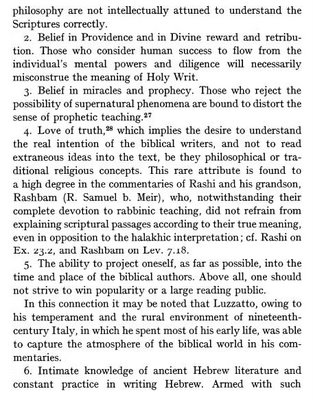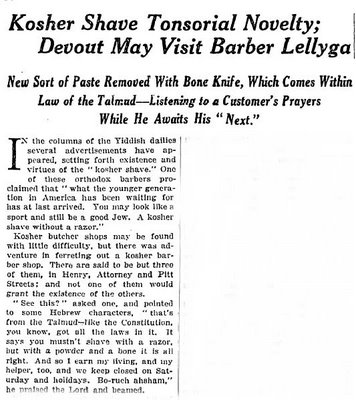Aleppo Codex enthusiasts will be interested in this short letter Moshe David (Umberto) Cassuto
[1] sent Paul Kahle, printed in Kahle's 1953
review article The New Hebrew Bible, Jerusalem 1953 in
Vetus Testamentum, Vol. 3, Fasc. 4. (Oct., 1953), pp. 416-420. (orig. in Italian, trans. by Kahle).
For those who are not yet enthusiasts there will be some brief background toward the end of the post
[2]:
The Aleppo manuscript, however, destroyed by vandal barbarians, if the accounts given in the press are true[3], was examined by me at length during a visit which I paid to Aleppo for the purpose four years ago. Direct examination of the codex aroused great doubts about its identification with the codex which was in the hands of Maimonides. This tradition which you regard as indubitable (emph. mine) is certainly very old, but it is not proved, and there are some reasons to query it. That the codex used by Maimonides is that of which the part containing the Prophets is preserved to day at Cairo, is mentioned only in a tentative way in the prospectus attached to the edition of Jonah (ie, in the 1953 Hebrew University Bible), and is not more than a conjecture. All the same, the reasons which you advance to the contrary are not so strong as to exclude this possibility.
...Of the Codices of Cairo, London and Leningrad I have with me complete photographs, and of that of Aleppo as much as I could copy at the place. I am the only modern scholar who has succeeded in obtaining (and with how great and how many difficulties!) permission to study at leisure this codex. In spite of all my efforts I could not obtain permission to photograph it, because the leaders of the community at Aleppo were convinced that they would have been exposed to all the curses written in the codex [4]. Naturally it is impossible to overcome such a superstition coupled with the fear of death. Not even the danger of the destruction of the codex, which had been foreseeable for some time, and which I put before the leaders of the Community, was sufficient to convince them of the usefulness of a photgraph. For them the codex was a sort of palladium which protected them and did not need to be protected. In their eyes it was something sacrosanct, rich in thaumaturgic value, which a photograph would have profaned and for which no photograph would have been able to provide a substitute.[1]Here is a photo of Cassuto:
 [2]
[2]Brief background promised, now less brief then I intended:
The Aleppo Codex (כתר ארם צובא) was the possession of the Jewish community of Aleppo, Syria for centuries. It was regarded as a treasure, which is why it was called by them The Crown; הכתר or
'el-Taj. By tradition it was regarded as having been written (or rather vocalized) by the greatest Masorete,
'Aharon (ben Moshe) ben
'Asher, which is what a colophon page in the book claimed. Furthermore, it was believed that this was the very book which the Rambam consulted in writing his own
sepher Torah, as recounted in
Mishne Torah Hilkhot Sepher Torah 8:5.
Now there is nothing wrong with such a tradition--especially considering that this turned out to be perfectly genuine--aside for the fact that such traditions are often faulty (and such colophons are often written by later hands). Given this, the fact that this particular great Bible codex was 1) written by this ben
'Asher and 2) the one the Rambam consulted in Egypt was not established. Proof would be needed.
Although for centuries various Jewish communities had been sending representatives to consult the codex, it was not (in theory) until the 1940s when permission was granted to a modern Bible scholar, Professor Rabbi Umberto Cassuto, that the codex could be examined with, as parts of its goal, an eye toward determining if this really was the codex the Rambam used. As one can see in the letter to Kahle, it was not easy to get permission to view it and he was forbidden from having it photographed. Be that as it may, he spent many hours with it (around 24 in total) and took extensive notes. He returned to Jerusalem with a verdict: this is not the codex the Rambam used. This opinion of his was reflected in the letter above; he told Kahle he is wrong for thinking it is that same codex.
In any case, he never got the chance to publish his reasons why he was sure it was not the right codex although it was known that one of the reasons was because the AC didn't match the Rambam's description.
Although there is a more extensive history, suffice it to say that the first convincing rebuttal of Cassuto's formidable opinion came in 1960 in the first issue of the Hebrew University Bible Project's annual journal Textus. M.H. Goshen-Gottstein pointed out that Cassuto probably objected to the following facts:
1) In the Mishne Torah the Rambam says that the
shirah of
parashat ha'azinu must be written on 70 lines in a Torah (fully in accord with
massekhet sopherim, I believe, sorry no cite at the moment).
2) In the Aleppo Codex this is written on 67 lines.
This would seem reason enough to conclude that this wasn't then the codex used by the Rambam, even with the long tradition.
However, pointed out eagle-eyed Goshen-Gottstein, there is a mistake. It says 70 lines in all printed editions of the Rambam. What about old manuscripts? Sure enough, in the most authoritative manuscript of the Mishne Torah (in Oxford's Bodleian Library, the Huntington 80 mss) it says 67 lines, not 70. (Why is this the most authoritative manuscript? Because
this appears in it.
Of course there are other reasons why this has to be the right codex. It matches every description of the codex through every century. Long story short, this is the one. Although there is some question whether this is really
the best masoretic manuscript there ever was, there is no question that it is the most accurate extant, in the sense that it agrees with itself in a way that no other masoretic manuscript comes close. In other words, there is a good reason it had the excellent reputation it had, which is why the Rambam used it.
[3]Obviously these early reports were not true; even though the synagogue in Aleppo was in flame, about 2/3rd of the AC survived and was smuggled into Israel in 1958. Many regard the other third, including most of the Torah, as missing rather than destroyed since at least one missing leaf has turned up since and the AC does not appear to have been touched by fire at all.
[4] Presumably to those who remove it from its location. Such blessings and curses are common in massoretic codices. Although I don't have the text of the one in the AC handy, Paul Kahle (Cairo Geniza pp.112-115) reproduced the text in the colophons of the Codex Cairensis (Cairo Codex), which was written by Moshe ben
'Asher, the father of the AC's masorete
'Aharon ben
'Asher. Here is a sample (there is an earlier introduction by Moshe ben
'Asher, praising and blessing the owner of the codex; presumably he paid big $$ to have it written, one Ya'abes ben Shelomo. In addition, there are other paragraphs added long after Moshe ben
'Asher's time. I am assuming that such an introduction as the one here is also in the AC; I don't know for sure, I only know that the AC has (or rather
had) one:
אני משה בן אשר כתבתי זה המחזור שלמקרא על פי כיד אלהי הטובה עלי באר היטב במדינת מעזיה טבריה העיר ההוללה כשהבינו עדת נביאים בחורי יי קדושי אלהינו המבינים כל נסתרות והמשפירים סוד חכמה אילי הצדק אנשי אמנה לא כיחדו דבר ממה שניתן להם ולא הוסיפו מאמר על מה שנימסר להם והעצימו והגדילו המק' עשרים וארבעה ספרים וייסדום באמונתם בטאמי שכל בפירוש דיבור בחיך מתוק ביופי מאמר יהי רצון מלפני יוצרנו שיאיר עינינו ויגיה לבנו בתורתו ללמד וללמד ולעשות בלב שלם ובנפש חפצה ולכל ישראל אמן
נכתב לקץ שמונה מאות שנה ועשרים ושבע שנים לחורבן הבית שני שיאמר יוצר נשמות וישוב עליו ברחמים ויבנהו באבני אקדח וספיר וכדכד בנין שלם בנין מקויים בנין שלא ינתש ולא יהרס ולא ינתץ לעולם ולעולמי עולמים במהרה בימינו ובימי כל ישראל אמן
וכל המשנה מן המחזור הזה או מן הנשתון הזה דבר או מוחק ממנו אות או קורע ממנו דף אלא אם צן יבין וידע שיש בו דבר ששגינו בו בכתב או בניקוד או במסרת או בחסר או ביתר אל יהי לו לא מחילה ולא סליחה ואל יחזה בנעם יי ולא יראה בטוב הצפון ליריאיו ויהיה כעשה נדה וכמצורע מוסגר כתת אבריו ולשבור גאון עזו ולכלות בשרו מראי ולשפות עצמותיו שלא יראו אמן
הקורא ישמע והשמע יבין והראה ישכיל שלום
I, Moshe b. Asher, have written this Mahzor of the Scriptures, according to 'the good hand of my God upon me' (Neh. 2.8), 'very plainly' (Deut. 27.8), in the city of Ma'azya Tabariyya, 'the renowned city' (Ezek. 26.17), as it was understood by the congregation of the Prophets, the chosen of the Lord, the Saints of our God, who understood all the hidden things and embellished the secret of wisdom, the chiefs of righteousness, the men of faith. They have not concealed anytihg of what was given to them, and they have not added a word to what was transmitted to them, and they have strengthened and made mighty the Scriptures, the Twenty-Four Books, and they have established them in their integrity, with explanatory accents, with a commentary of pronunciation, with sweet palate and beauty of speech--may it be the will of our creator to enlighten our eyes, and to illuminate our heart in His Tora, to learn and to teach and to act 'with a perfect heart and with a willing mind' (1 Chron. 28.9)--and for all Israel! Amen.
It was written at the end of the year 827 after the destruction of the Second Temple, about which may the Fashioner of souls ordain, and may he return to it in compassion, and may he build it with rubies and sapphires and carbuncles (Isa. 54. 11, 12) as a perfect building, as a well-established building, a building which shall neither be plucked up, nor demolished, nor destroyed, for ever and for ever and ever, speedily, in our days, and in the days of all ISrael. Amen!
Whoever alters a word of this Mahzor or of this writing, or erases from it a letter, or tears off from it a leaf--except that he understands and know that there is in it a word in which we have erred, in writing, or in punctuation, or in Masorah, or in defective or in plene, let him not have pardon or forgiveness, neither let him behold the beauty of the Lord (Ps. 27.4), nor let him see the good that is reserved for those who fear him (Jer. 29.32) He shall be like a woman in impurity, and like a leprous man who has to be locked up, so that his limbs may be crushed, the pride of his power be broken, his flesh be consumed away that it cannot be seen, and his bones that are not seen stick out (Job 33.21). Amen.
Whoever reads shall hear, whoever hears shall understand, whoever sees shall perceive. Peace!
















